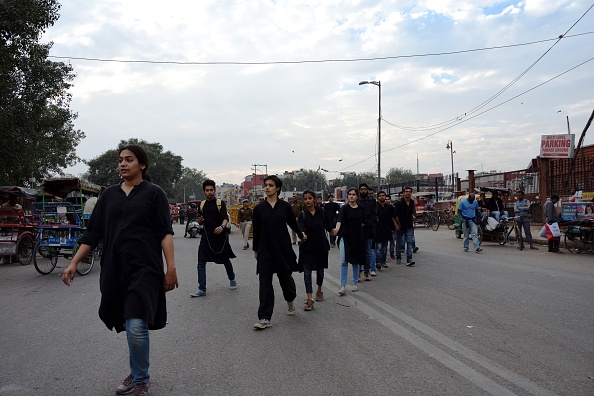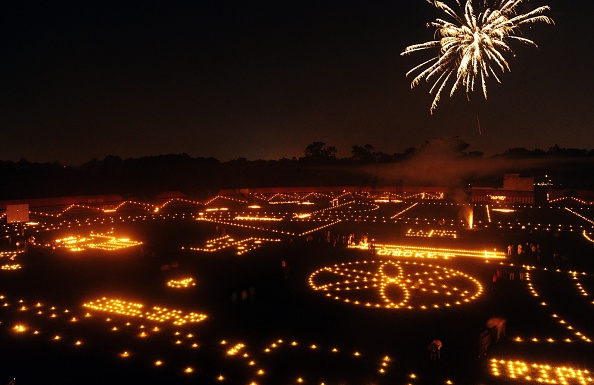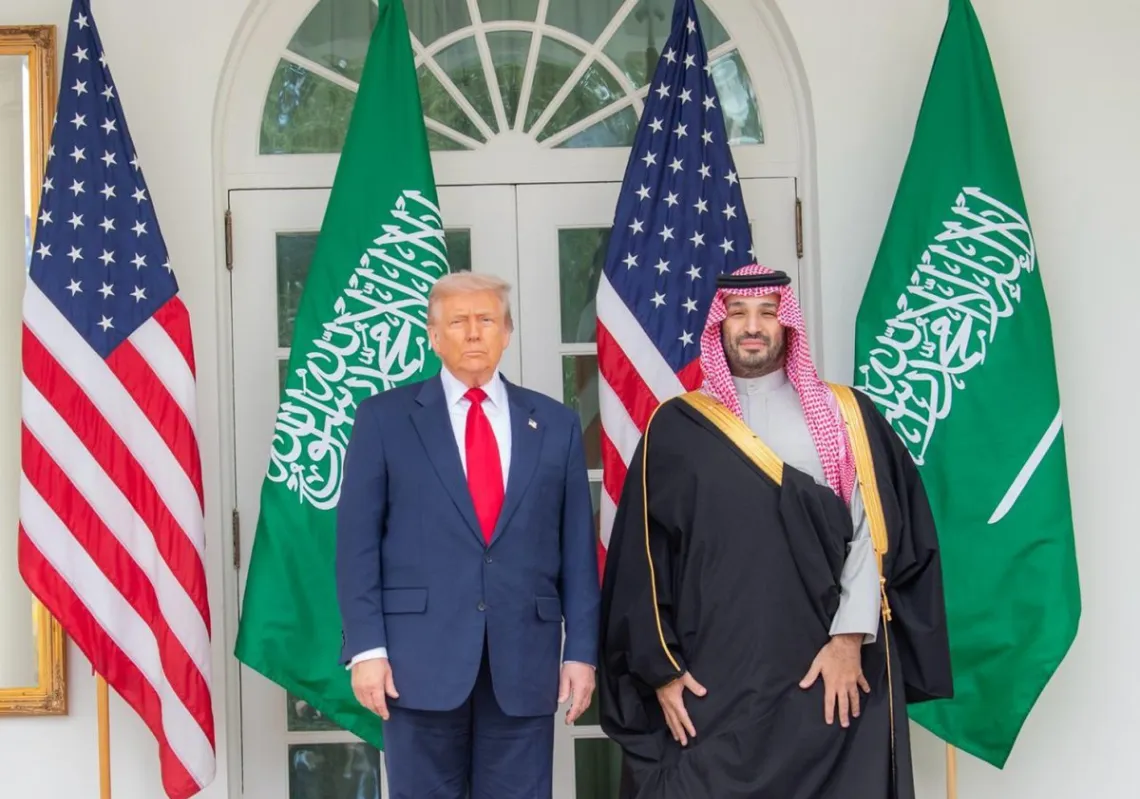Yet what has gone unnoticed in Vajpayee’s death is the passing of an older, pluralist idea of India. In 1997, the historian Sunil Khilnani described "the idea of India,” usually attributed to the country’s first prime minister, Jawaharlal Nehru, as an imagined secular, pluralist, polity that belonged to all Indians and not to any one group. In particular, India did not belong to the Hindu majority, which constituted 80 percent of the country’s population according to the last official census. It was this secular idea that created India in 1947, not as the Hindu mirror of a Muslim Pakistan, but as the pluralist opposite of majoritarian nationalism.
Now, things have changed. With the BJP’s rise to become India’s governing party, the idea of India is being redefined to mean a Hindu polity. Through acts of violence as well as words and laws, India is debating not whether the country’s political system should recognize Hindu identity, but the precise way in which it should be recognized.
MODERN NATIONALISTS
The BJP, which has for decades called upon the government to recognize the special rights of Hindus in a Hindu majority country, has been the single most important force in shifting the terms of debate. But that call now goes beyond the BJP. It has become part of a zeitgeist that animates a diverse collection of Indians, from global professionals looking for an identity to arm themselves with in a world where everyone else seems to already have one; to the small town graduates who see themselves reflected less in an Anglicized elite than in politicians who use Hindu religious metaphors; to the young rural men who take part in spectacular, mass, synchronized religious rituals, oddly reminiscent of the megachurches of the American South.
These are not backward-looking citizens lost in the glory of an imagined past. They are people concerned with the future, searching for an identity to help them navigate a modern, globalized world in which India is on its way to becoming an economic superpower. Many of them find that identity in a reimagined Hinduism, which serves both winners and losers in India’s new economy.
The winners—a cosmopolitan elite, as comfortable in London or New York as in Chennai or Delhi—need cultural references that place them on a par with their counterparts in the West to mark their arrival on the world stage. Hindu symbols, refurbished for the twenty-first century, often provide those references. Diwali (a festival of lights, popular among Hindus in north India) becomes an answer to Christmas and the Ramayana and Mahabharata (two of the many texts associated with Hinduism) become the answer to the Bible. For many of the losers—in particular young men in India’s small towns and villages for whom globalization and economic growth have brought greater aspirations but not new jobs or a better education—the mass rituals now associated with Hinduism offer communal solidarity.
The idea that some form of Hinduism should be recognized in some way by the Indian state resonates among both the cosmopolitans and the dispossessed. What is at issue is how it should be recognized. The BJP is the main political party addressing this concern. Prominent leaders in the party and its parent organization, the Rashtriya Swayamsevak Sangh (RSS), have offered four proposals, all of them taking up the crucial questions not just of what place non-Hindus should have in India’s political system, but also of who counts as a Hindu, and what counts as legitimate Hinduism. The label “Hindu” encompasses a great range of communities, beliefs, practices, and languages. If Hinduism is to be recognized by the state, whose Hinduism should it be?

WHOSE HINDUISM?
The first argument on offer holds that the Indian state should recognize Hinduism as at least symbolically pre-eminent, while guaranteeing equal rights to all citizens, including those from religious minorities. This first-among-equals view calls for India to recognize Hindus in a way that is roughly comparable to the way in which the United States recognizes Christians, for example: by privileging Christmas as a national and official holiday while not privileging the rights of Christians as a religious group.
This soft pro-Hindu view, often found among those who have joined the BJP directly (that is, not by way of the RSS or its affiliated organizations), challenges the Nehruvian idea of a state blind to religion. That idea is currently enshrined in law: the Indian state does not privilege Hindu religious holidays. Government offices close for the holidays of all major religious groups.
If the first-among-equals view were to become law, it would not necessarily entail inequality in legal or material rights and entitlements, but it would leave non-Hindus—and those Hindus who do not follow whichever branch of the religion the state ended up recognizing—lesser owners of their country in a symbolic sense. If the state is going to mark Hindu holidays, for instance, it would have to decide whether to privilege Diwali (the biggest festival of the year for many north Indian Hindus), Durga Puja (the major festival of Hindus in West Bengal), Ganesh Chaturthi (for those in the west of India), or Onam (the major Hindu festival in Kerala). The pluralist idea of India avoided this problem entirely.
The second argument—call it majoritarianism—goes further. India, it holds, should adopt laws that privilege its Hindu majority while giving non-Hindus diminished legal status. This is the standard position the BJP and many of its leaders have articulated over the last two decades. If majoritarianism were to prevail, India’s non-Hindu minorities would become second-class citizens. Many Hindus might become second-class citizens, as well.
To see this, consider the BJP’s position that the Indian state should ban the slaughter of cows because the cow is sacred to Hindus. This idea has assumed a new urgency following a recent spate of lynchings of those, often Muslims, accused of killing cows. Some senior BJP leaders have openly backed the killings. But as with most beliefs associated with Hinduism, some Hindus hold cows sacred and others don’t. There are many perfectly traditional beef-eating Hindus, especially in southern and northeastern India. It should be no surprise that many of those lynched for cow slaughter have been Hindus. A rough count conducted by the Hindustan Times of 50 cases of “cow-terrorism attacks” since 2010 in which the identity of victims was discernible found that in at least one out of every four cases, the victim was Hindu. There are also many non-traditional atheist Hindus who do not hold the cow sacred. A ban on cow slaughter would discriminate against these Hindus and non-Hindus alike.
According to the third argument, Hindus constitute not only a religious majority but also a nation in themselves. This nationalist view has long been the position of the RSS and of RSS traditionalists within the BJP. It is also the position reflected in the Citizenship Amendment bill, a proposed law introduced by the BJP in 2016 and now under consideration by parliament, which seeks to covertly privilege Hinduism through amendments to India’s citizenship laws. This position would demand the assimilation of India’s non-Hindu minorities and has already been by used by the RSS and its affiliates to justify forcing Muslims to convert to Hinduism, a process euphemistically termed “ghar wapsi” or “homecoming.” It would require the assimilation of many Hindus, too, into whatever interpretation of Hinduism the state espouses.
The fourth argument is the most extreme. Its proponents believe that not only should Hinduism form the basis of the nation but India should be a theocratic state with a religious leadership. The BJP and the RSS are not sympathetic to this view. But in 1964, as part of an effort to mobilize the Hindu majority, the RSS created the Vishwa Hindu Parishad, or “World Hindu Council,” whose professed goal is to unite the Hindu clergy on a single ecclesiastical platform. Many in the VHP espouse a theocratic idea of the Hindu nation and have now developed an independent popular base. Last year, Modi appointed the religious leader and VHP member Mahant Avaidyanath to be the chief minister of Uttar Pradesh, India’s most populous state. The selection demonstrated the degree of pressure that this theocratic tendency and its constituency exert on the RSS and BJP.

NATIONALISM ASCENDANT
Viewed along this spectrum, Vajpayee, an advocate of the majoritarian view, was no moderate. He sought to privilege Hindus over other religious groups, in a radical departure from India’s founding ideology. Only the emergence of even more extreme versions of Hindu nationalism allowed Vajpayee’s position to come across as middle-of-the-road.
Take Vajpayee’s reaction in 1992, when a mob aligned with the BJP destroyed a sixteenth-century mosque in the town of Ayodhya, in North India. The BJP had previously campaigned to replace it with a Hindu temple. Unlike some BJP leaders, Vajpayee was not present at the demolition and apologized in the days that followed. But he apologized only for the spontaneous and uncontrolled destruction of the mosque, not for the original position that a temple should replace the mosque. He had always supported that view and made a speech saying as much just the day before the mosque was demolished.
Vajpayee’s “moderation,” such as it was, came from his personality and his love of poetry, which often overcame his ideology. He had a large heart, a poet’s eloquence, and a poet’s indiscipline in sticking purely to ideological matters. These traits helped him build and sustain relationships across ideological lines. They also allowed him to connect instantly with a crowd. I have stood at his rallies, mesmerized by his turns of phrase. At one, he told stories of the Emergency imposed by Prime Minister Indira Gandhi between 1975 and 1977, during which many opposition leaders were jailed. Vajpayee had been one of them, and he spoke of undergoing surgery in prison that had permanently injured his back. “Now,” he said, “I am incapable of genuflection, even if Mrs. Gandhi were to order me to bow before her.” The crowd roared with laughter. They liked and respected him. I did too. But eloquence and an affable personal style do not add up to ideological moderation. Vajpayee’s words and actions often transcended ideology. But when he did take an ideological position, it was unswervingly majoritarian.
Vajpayee’s lack of moderation does not mean that there is no moderate way of responding to the search for a Hindu identity in the symbols of state. The pluralist idea of India that Khilnani wrote about contains the ingredients for such a moderate response, since it offers equal respect not only to India’s non-Hindu minorities but also to the many different ways of being Hindu.
But Nehru’s successors gave up on that pluralist idea long ago. His daughter, Indira, stoked the anxieties of the Hindu majority in her election campaigns in the early 1980s. His grandson Rajiv Gandhi courted the Hindu majority by launching his 1989 election campaign from the town of Ayodhya and calling for “Ram Rajya,” the rule of Lord Ram. Now, his great grandson Rahul Gandhi, the current leader of the Congress Party, has begun to flash his own pro-Hindu credentials. During regional elections last year, he made conspicuous visits to temples. In September, in anticipation of the 2019 parliamentary elections, he set off on a pilgrimage to Mount Kailash in Tibet, which many Hindus consider to be the home of the deity Shiva. On the way, he tweeted that “Shiva is the universe,” and published Fitbit data showing each of his steps along the pilgrimage route, turning what could have been a private visit into a political spectacle. Days later, the Congress party put up election-related posters declaring Gandhi a devotee of Shiva. This half-hearted attempt at beating the BJP at its own game ensures that some form of Hindu majoritarianism will win in India’s 2019 parliamentary elections—no matter who loses.
This article was originally published on Foreign Affairs.








